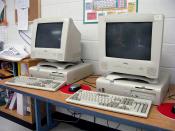In today's world, technology is the key to problem solving. From the earliest inventions to today's constant upgrades, inventors, designers, and creators start with a problem and develop ways to solve the problem efficiently. However, technology and inventions do not stop at efficient: people continue to find easier and more convenient solutions. For example, communication moved from hieroglyphics and word-of-mouth to mail, telephone, cell phone, email, and even video capture or webcam. We use technology in nearly every aspect of life and our children need to be prepared to enter a nation that requires knowledgeable being in not only the three R's but also the ever-rapidly changing and growing field of technology. Our education system must determine the most beneficial methods of applying and integrating technologies into our schools. One current debate is the placement of computers in the classroom or in a lab environment. Even though computers in the classroom promotes the benefit of maximum computer usage, computer lab setting are more efficient in building essential skills necessary for the integration of using technology in academic tasks.
More than two decades of research has shown decisive evidence that the use of technology in education leads to positive effects on student achievement. During testimony before Senate Subcommittee, Margaret Honey (2001) indicated "â¦technology implementationsâ¦increases students' performance on standardized tests, software supporting the acquisition of early literacy skills can support learning gains, and scientific simulations, microcomputer-based laboratories, and scientific visualization tools have all been shown to result in students' increased understanding of core science concepts." Furthermore, software designed to support problem-solving enables students to grasp key mathematical concepts and language software such as Rosetta Stone permit students to learn at a more rapid pace and facilitate a sufficient learning environment. Internet access provides opportunities for numerous exploration, communication, and research. Internet access, computer software, and other educational technologies have improved the quality of education and strengthened skills in subjects such as math, science, and language.
Technology has not only improved the quality and skills in student education, but technology has also proved to be a valuable asset for teachers and their professional environment. Software developed to collect data, chart student progress, identify student trouble areas, and modify instruction for student success is an example of a diagnostic assessment tool that teachers can use to perform work effectively especially with the onset of NCLB (No Child Left Behind Act). Technology enables teachers to collaborate and work together to develop lesson plans and curriculum where in the past, teachers were largely isolated from colleagues throughout the workday. The range of archival materials available on the web has given teachers and their students access to materials that would otherwise be available only to specialized scholars or academic researchers. There are many benefits of technology that increase opportunities and efficiency of the teaching profession and student achievement.
The improvement on student achievement due to technology is also appealing to employers who require computer skills and to students entering the workforce with computer and technology education. Richard W. Riley (1997), the former secretary of the Department of Education, described the future of technology by saying, "The wealth built by our forebears from coal, steel, oil, concrete, and brawn can be built tomorrow from silicon chips, integrated circuits, digital networks, computers, and raw intelligence." This statement was given over 10 years ago and now is the time Riley was referencing. Among others, Riley was aware of the need to educate our country's children with a variety of technology and techniques because of the rapid growth and development of new products, gadgets, software, and hardware designed to help businesses run more efficiently. Performing a job search in today's market will prove how different technology skills - from typing 40 words per minute to operating specific software - are necessary for career competence and obtaining a job.
Technology has been proved useful and essential in the education system of the United States in many different aspects. Integration of technology improves student achievement, work efficiency, and is important for students' futures. Now we must tackle the question of how to integrate technology and apply meaningful techniques that are going to lead to capable students. In the past, computer labs have been the primary source for students to learn technology applications and labs are still in full use today, but one side of the debate argues that computer labs are isolated causing difficulty integrating technology into other areas of curriculum. Advocates for computers in the classroom argue that access to computer labs is far from the critical level needed to impact learning experiences of children. Many advocates believe that computers in the classroom promote more interactive styles of teaching. Barbara Barr (2005), a 24 year teaching veteran, is convinced that computer labs are disadvantageous because labs "[do not] allow ample time to work on projects" whereas computers in the classroom provide convenience, efficiency, and proper integration. Not only are computers beneficial to improving student achievement, but they are a crucial component of technology integration in our education system.
Proponents of computer labs suggest that computer labs offer many more advantages over computers in the classroom and labs should not be phased out of educational activities. Ferdi Serim (2005), computer lab teacher, coauthor of the book Net learning: Why Teachers Use the Internet, and editor of Multimedia Schools Magazine, describes computer labs as "effective places to give all students adequate access to technology to perform meaningful work." Other proponents including teachers, educators, and even students express that the computer lab environment has usually has more space to work and fewer distractions from other activities that go on in the regular classroom. In one study comparing technology skill development in computer labs versus classroom settings the findings were obvious. Results from the study proved that compared to classroom integration, using the computer lab had higher overall scores in computer skills (Rule, Barrera, & Dockstader, 2001). This decisive study is valuable in determining the importance of computer labs and maintaining a positive outlook on the value they provide.
Both sides of the debate have valid arguments but many of the disagreements are direct contradictions. Proponents of phasing out computer labs believe that classroom integration allows adequate time for computer access and opponents of extinguishing the computer lab use the same argument. They believe that the lab environment provides the time and space needed to gain essential computer skills. A second contradicting argument involves the environment surrounding technology usage. One side of the debate is in favor of integrating computers and technology in the classroom to promote maximum benefits of computer usage while the other side believes computer labs provide necessary skills in basic computing that cannot be obtained as easily in a classroom environment. Both opponents and proponents of phasing out computer labs can agree that technology is a necessary and important component in today's education but these opposing viewpoints lead one to believe that a different underlying issue is being ignored.
What is emerging from this debate is not that computer labs are better or worse for technological education, but that both computer labs and computers in the classroom have potential benefits that cannot be ignored. Most of the views from both sides argue the positive effects of their particular side but neither has come up with enormous substantial evidence proving that one way is better than the other is. We must begin looking at the benefits of having computer labs where students are able to focus at the single task at hand and integration of computers in the classroom where the teacher has full control of usage. Ideally, students should have access to computers and other technologies on a daily basis for the purpose of research, word processing, communication, and many other real-world applications. Perhaps someday our nation's students will each have a laptop computer that check out at the beginning of the school year and check back in at the end of the school. Students would be able to use the computer for their personal educational needs similar to a textbook but until then teachers must figure out ways to enrich the skills of students with the technology at hand.
A last topic that needs to be addressed is the role of the Federal Government in technology education. The Federal Government has taken huge steps to ensure the equal education of all United States students. The U.S. Department of Education's Office of Educational Technologies has provided leadership by defining and administering programs, brought together state and local technology leaders, and promoting a vision for effective technology use in our schools (Honey, 2004). The Federal Government has funded 35% of all educational technology, which is outstanding compared to the 6.6 percent of overall contribution to education funding. Leadership and funding are two of the largest and most important aspects in progressing technology education and the Federal Government is extremely important for maintaining these critical roles.
In education, it is not always the physical location of where the learning takes place that makes the difference. It is the teacher's intuitivism, nurturing, and caring that matters. It is the teacher's creativity, understanding, and support that bring forth the full potential of students. These teachers must work in a context that is supportive and receptive to the use of technology in order to have an impact on students' learning. Individual schools and school districts must be well organized for technology use. The federal government must continue to provide funding and leadership while playing a role in educational technology. All these components lead me to believe that phasing out computer labs is not an option. Leadership and context need to be put in place so computer labs can be used, maintained, and updated properly to ensure quality learning experiences and essential skills that will lead students to higher achievements. I believe that computer labs still fit the bill for education.
âÂÂWorks CitedHoney, M. (2004). Technology Has Improved Education. Opposing Viewpoints: The Information Revolution. San Diego: Greenhaven Press. Retrieved from Opposing Viewpoints Resource Center on October 29, 2008.
Hess, Frederick M. "Technical difficulties: information technology could help schools do more with less. If only educators knew how to use it (Forum)." Education next. 4. 4 (Fall 2004): 15(5). Retrieved from Opposing Viewpoints Resource Center. Gale. Apollo Library. 30 Oct. 2008.
Johnson, J. A., Musial, D., Halle, G. E., Gollnick, D. M., & Dupuis, V. L. (2005). Introduction to the Foundations of American Education (13th ed.). Boston: Pearson.
Riley, R.W. (1997). Computer Education is Vital for Students of the Future. Current Controversies: Computers and Society. San Diego: GreenhavenPress. Retrieved from Opposing Viewpoints Resource Center on October 29, 2008.
Rule, A. C., Barrera, M. T., & Dockstader, C. J. (2001). Comparing Technology Skill Development in Computer Lab versus Classroom Settings. Retrieved October 25, 2008, from NCOLR: http://www.ncolr.org/ /issues/PDF /1.1.5.pdf





